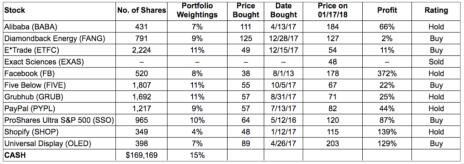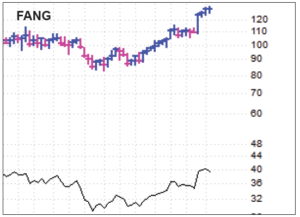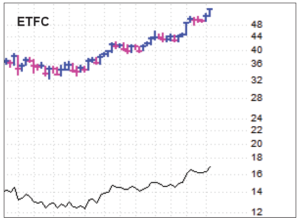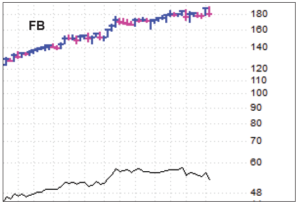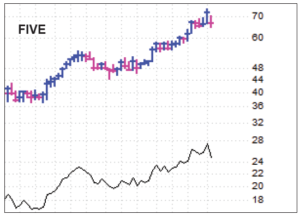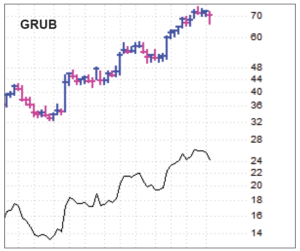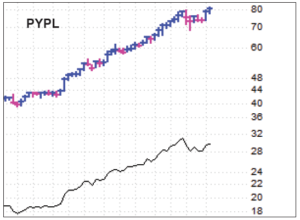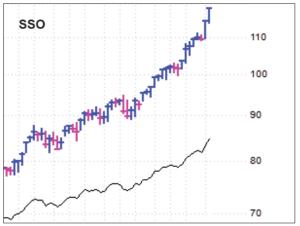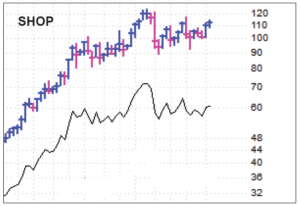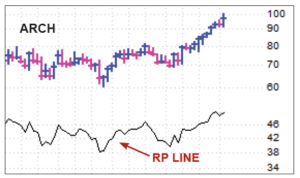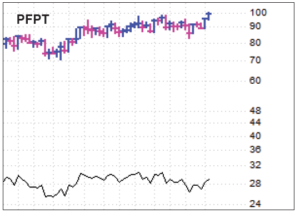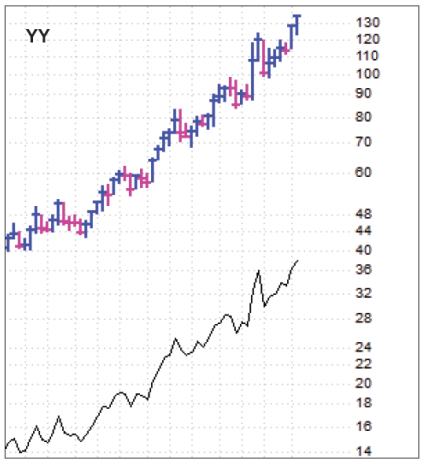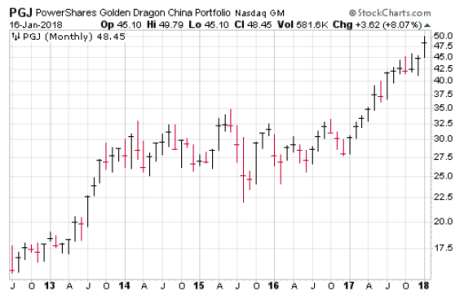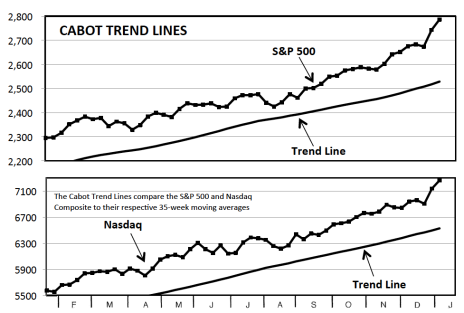The market continues to zoom higher amid a vacuum of selling pressure. In the short-term, though, we’re not seeing a lot of stocks at great entry points and earnings season is coming up, both of which could lead to some pullback or retrenchment, at least on a stock-by-stock basis. But longer-term, there are many positives that tell us the odds strongly favor higher prices down the road.
Cabot Growth Investor 1385
[premium_html_toc post_id="143467"]
A Vacuum of Selling Pressure
It wasn’t that long ago, in the months after the U.S. Presidential Election of November 2016, that investors were more skittish than a field mouse. Whether it was worries about big, geopolitical issues (North Korea) or fears about Washington’s actions surrounding certain industries (like drug pricing), traders seemed to bail out on any piece of bad news.
Fast forward to today, and it’s a different ballgame. Gone (for now) are the worries about the Fed, the economy and just about everything else, replaced by optimism surrounding the recent corporate tax cuts and accelerating economic growth. The major indexes have enjoyed an amazing run—the S&P 500 has closed below its 25-day line just once since the start of September, and so far in 2018, has catapulted higher amid a vacuum of selling pressures.
In the short-term, we’re probably getting close to the point of a pullback or pause. We’ve already written a few times about elevated sentiment, so we won’t repeat that here. But now we’re also seeing very stretched market-based readings—yesterday, for instance, saw the greatest number of new highs on the NYSE and Nasdaq since early December 2016!
Given that we’ve already had a big run in recent months, some uneasiness during earnings season wouldn’t be shocking. That doesn’t mean you should bail out of your winners and try to buy them back lower (a strategy that, as attractive as it sounds, rarely works out well). But it is a sign to be choosy on the buy side, looking for low-risk entry points, preferably on dips.
All that said, we’ll continue to point out that the market’s unusual strength of late very likely is a sign that this bull market has further to run—major uptrends almost always end after a period (weeks or months) of topping out, so the odds of a meaningful high soon are small. In fact, later in this issue, we review a handful of blastoff indicators and studies that all point higher three to 12 months down the road.
Put it together, and we remain very optimistic overall; we’re still giving our winners a chance and think many have great potential over time. Short-term, though, we’re keeping our feet on the ground, holding a little cash, honoring our mental stops and watching how earnings season plays out.
[highlight_box]WHAT TO DO NOW: Remain bullish but stick to the plan. In the Model Portfolio, we sold Exact Sciences (EXAS) last week, leaving us with 15% cash. We’re not opposed to doing some buying, but for now, we’re more focused on managing our holdings as earnings season begins.[/highlight_box]
Model Portfolio Update
Having bought Diamondback Energy at the tail end of December, we came into 2018 heavily invested (less than 10% in cash) and aiming not to do much during the first couple of weeks of January given the month’s reputation for quirky action. For the most part, we’ve succeeded, though we did pull the plug on Exact Sciences last week after an abnormal-looking selloff and overall pattern.
Given where the market stands (very extended to the upside in the short-term with bubbly investor sentiment), we’re not eager to do much new buying right now. That said, given the many longer-term positives out there, we’re certainly keeping our eyes open—earnings season usually launches some new leadership, and the odds favor any pullbacks or shakeouts in leading stocks producing some solid entry points.
Thus, at the moment, our focus is mostly on managing our current positions, but we’re continually updating our Watch List and looking for opportunities, preferably on weakness. If you’ve just joined us recently, you should follow a similar plan—Buy-rated stocks can be bought, but preferably on dips and consolidations.
Current Recommendations
HOLD—Alibaba (BABA 184)—Alibaba has been relatively quiet on the news front during the past couple of weeks; the acquisition of MoneyGram by Alibaba-sponsored Ant Financial fell through, but the market didn’t seem to care much. The stock has done a decent job of holding its recent gains, but it’s still battling resistance near 190, its relative performance (RP) line is meaningfully shy of its old highs and earnings (due out February 1) will be announced in a couple of weeks. If you don’t own any and want to start a small (half-sized) position here, we’re not going to argue. But officially, we’re going to stick with our Hold rating until we see more strength from the stock and its RP line, which would give us more confidence that the stock’s multi-month rest period is over.
BUY—Diamondback Energy (FANG 127)—New leading stocks usually break out powerfully and then immediately follow through to the upside without any pullbacks, and that’s just what FANG did after it got going in mid-December. Of course, as an energy stock, it’s a good bet that shares will be choppy based on oil and gas prices, but we’re thinking the commodity complex as a whole has turned the corner as investors look ahead toward faster economic growth. One part of the Diamondback story we think is underrated is the company’s majority-owned subsidiary Viper Energy (symbol VNOM), which owns a bunch of mineral rights (i.e., drilling rights) for Diamondback and some other acreage in the Permian Basin. And it’s valuable! VNOM’s market cap is currently $2.7 billion and Diamondback owns 64% of it! Plus, at the current distribution rate, VNOM will pay Diamondback about $1 per share of dividends each year. Back to FANG, we think you can buy some around here or on dips of a couple of points if you’re not in yet.
BUY—E*Trade Financial (ETFC 54)—ETFC will report fourth-quarter results next Thursday evening (January 25). The numbers will obviously be important (analysts expect revenues to rise 24% and earnings of 61 cents per share, up 33%), but so will the data on customer trading activity (including any initial results from Bitcoin futures trading, which E*Trade recently enabled) and any further color from management on the effect of tax cuts and likely short-term interest rate hikes by the Fed. Analysts have ratcheted up their estimates (partially due to the tax cuts) for 2018 and are now looking for the company’s earnings to rise 37%. As for the stock, it’s lifted to new highs after a nice, tight December pause. We’ll stay on Buy, though as with most leading stocks, aim for dips.
SOLD—Exact Sciences (EXAS 48)—We sold EXAS last week after the stock collapsed on its heaviest selling volume in more than six months (more than quadruple its average). Shares did bounce a bit, but have since gotten hit on a $600 million convertible bond offering (which is dilutive) and then, today, on news that a Taiwan-based study showed great promise for a blood test that could detect colon cancer. Whether this is “real” competition will probably take some time to figure out—we simply think that EXAS, after a giant run last year, is acting abnormally. We took a modest profit and are looking for fresher leaders to jump on.
HOLD—Facebook (FB 178)—After a sluggish last few months of last year, FB was looking like it had turned the corner in 2018, but then came news that the company is overhauling its news feed to make it more consumer friendly (but possibly less valuable as an advertising mechanism). We’ll leave the debate to others over whether this move is great, awful or somewhere in between; what we care most about is investor perception. And on that front, our antennae are up—FB’s RP line has now been sagging for about six months and isn’t much higher than it was back in November 2016. That’s not a death knell (as FB has matured, it’s had many dead periods followed by a resumption of the overall uptrend), but it’s enough for us to switch back to Hold. Looking forward, earnings (due out January 31) will be key—a positive reaction could finally spark some upside momentum, but any drop into the low 160s would probably be a sign that FB’s position as a market leader has passed.
BUY—Five Below (FIVE 67)—FIVE took a big hit early last week after the company’s new fourth-quarter guidance evidently didn’t live up to the market’s lofty expectations. It’s a shot across the bow, but the stock has steadied itself since then, and in a presentation last week, the firm boosted long-term expectations (it now sees potential for 2,500 stores in the U.S., up from 2,000 previously) and confirmed its fabulous store economics (payback in less than one year) and rapid store expansion plan for 2018 (125 new stores this year, which translates to a 20% boost to the store count). There will likely be more spending on distribution centers, too, but analysts don’t seem worried—Wall Street sees Five Below’s bottom line rising 27% this year, partially boosted by tax reform. A drop below the 50-day line (near 64) would have us going to Hold, but right now, we’ll stay on Buy, thinking the recent dip was a shakeout within an overall uptrend.
HOLD—Grubhub (GRUB 71)—We placed GRUB on Hold last week after a couple of heavy-volume days dropped it slightly below its 50-day line. Still, we remain optimistic that the stock has a bright future as it expands its reach—just yesterday, the company announced an expansion of its delivery services in both Greenville, South Carolina and Tacoma, Washington, with similar moves in the past proving to be big boosts to sales and margins. Analysts see both sales and earnings rising in the 35% to 40% range this year, and the stock quickly found support after its dip. We’ll stay on Hold for now, but much more strength from here would tell us the pullback is over. Earnings are likely out in the first week of February.
HOLD—PayPal (PYPL 82)—We’re certainly happy to see PYPL kick off 2018 with a bang, as the stock has motored higher by about 10% since the calendar flipped. The stock has picked up another analyst upgrade, which is nice, but the intermediate-term future will likely come down to earnings (no set date but probably near the end of the month) and management’s outlook. Like most growth leaders of last year, we think PYPL has plenty of upside over time, as the stock’s story is excellent and the prior uptrend only lasted for six months or so. But at this point, with the RP line still in a consolidation, we think it’s best to remain on Hold and wait for clearer signs of accumulation.
BUY—ProShares Ultra S&P 500 Fund (SSO 120)—Few would have guessed that SSO (which moves twice the daily percentage of the index) would put on the show it has during the past few months, rising from 100 in mid-November to 120 this Tuesday morning! Score one for simply following the trend! Later in this issue, we go in-depth on various blastoff indicators and other unique studies that all point toward higher prices in the months ahead. Short-term, though, there’s certainly a chance the major indexes back off because of elevated sentiment and some recent giddy market action. If you own some, then, we advise just sitting tight (though if you have a huge position, you could consider partial profits), and for new buyers, it’s best to target pullbacks of a few points given that the 25-day line is down around 112.
HOLD—Shopify (SHOP 115)—SHOP has perked up with most stocks so far this year, but what is more important to us is that, after four months of sloppy action, the stock is showing signs of being sold out—the stock’s four selling waves (early October, start of November, end of November and end of December) each came on successively lighter volume, with the final dip being very modest. It’s encouraging, and we continue to think Shopify’s e-commerce platform has years of rapid growth ahead of it as (mostly) small- and mid-sized business sign up. Even so, we need to see some buying power emerge before restoring our Buy rating—if you own some, continue to hold on with a mental stop in the mid-90s.
BUY—Universal Display (OLED 203)—OLED has roared back to life, tagging new price highs but (like many winners from last year) still leaving its RP line a bit short. However, we like the buying volume and, because the stock endured a five-month rest period through October of last year, the stock’s upmove is fresher than some of its growth stock peers. There’s been no news from the company, but any final Q4 sales numbers for Apple’s iPhone X or data from fourth-quarter OLED TV sales could affect the stock. We expect some short-term wiggles (200 could be round-number resistance), but the odds favor the next big move being up.
Watch List
Canada Goose (GOOS 33): It’s more thinly traded than we’d prefer, but Goose reminds us a lot of Michael Kors (another high-end retail play) when it came public in 2011. Growth is excellent and the next dip in the stock should prove buyable.
Freeport McMoRan (FCX 20): We don’t want to get too heavily into commodity stocks, but we love FCX’s chart, earnings estimates (up 51% this year) and as a general play on an accelerating economy.
Nutanix (NTNX 37): NTNX hasn’t gotten going with most stocks so far this year, but we still like the story and longer-term outlook, and the shakeout of the past couple of days is very intriguing.
Splunk (SPLK 91): SPLK continues to look fine, with a controlled dip into the low- to mid-80s marking a solid entry point.
Other Stocks of Interest
The stocks below may not be followed in Cabot Growth Investor on a regular basis. They’re intended to present you with ideas for additional investment beyond the Model Portfolio. For our current ratings on these stocks, see Updates on Other Stocks of Interest on the subscriber website or email mike@cabotwealth.com.
Arch Coal (ARCH 95) — It’s kind of a surprise to find coal stocks making a comeback, but we’re not going to argue with charts like the one ARCH sports. After its relisting in 2016, ARCH went through a long consolidation with support around 60 and resistance at 80. But with costs cut to the bone and plenty of cash on hand, Arch Coal’s cash flow has been huge, with management responding by buying back 10% of outstanding stock in the year after its relisting and another 2.5% in December. Management also instituted a dividend that yields 1.4% annually. Arch Coal’s product mix of metallurgical coal and thermal coal gives it exposure to international demand for steel-making and domestic demand for electricity generation, and demand and pricing have firmed up nicely in recent quarters. With its 25-day moving average now around 92, dips look buyable.
Atlassian (TEAM 55) — London-based Atlassian, as its stock symbol implies, is all about team productivity. The company says that it’s trying to do for team workplace productivity what Microsoft Office did for personal productivity all those years ago by coordinating workflow, messaging and content sharing in one relatively low-priced software bundle. The main target is software developers (there are about 21 million worldwide) and technical team members (another 100 million). The company doesn’t spend much on marketing, but has almost 90,000 organizations as clients. Atlassian will announce its fiscal second quarter results tomorrow (January 18) after the close, with forecasts calling for revenue of $277 million. TEAM gapped up in October, but fell hard in the November/December market correction. But it’s back above its November highs, and good earnings news could stoke the boilers.
Proofpoint (PFPT 98) — Cybersecurity stocks haven’t been on the leaderboard for quite a while, but Proofpoint might be ready to make its move. PFPT soared from 36 to 88 from February to November 2016, but was still trading at 88 in December 2017. That’s a heck of a long base for a company that scored 41% revenue growth in 2016 and has averaged 38% in the first three quarters of 2017. Thus, the company’s story and fundamentals are bright, but the stock’s future probably depends mostly on the results of Proofpoint’s Q4 and full-year results on February 6 after the market closes. Analysts are looking for Q4 revenue of $139.4 million and earnings of 20 cents per share. A gap to new highs would be very encouraging.
YY Inc. (YY 135) — Chinese stocks went through a flat patch from the middle of September through the end of 2017, but have been on fire since New Years. YY Inc. operates a unique streaming platform in China that allows users to interact via voice, text and video and share online activities like music shows, games, dating shows and e-learning. The company’s Q3 report revealed 37% growth in monthly active users and a 47% jump in live streaming paying users, a testament to management’s ability to keep adding compelling content to its offerings. YY traded flat in October, then jumped on huge volume in November. After slipping back to its 25-day moving average in December, YY took off and hasn’t stopped yet. Chinese stocks are back in investors’ sights, and YY is a favorite.
Bunches of Blastoff Signals!
We coined the term “blastoff indicators” a few years ago to describe a set of unique market indicators (or general market-based studies) that flash very rarely (once every few years if that) when the market shows unusual strength over a period of many weeks. These signals have a great record of predicting higher prices for the market months down the road (though the short-term is less certain).
What’s interesting is that we’ve seen a couple of these flash in recent weeks, plus there have been been several bullish longer-term studies because of the market’s strength, which tell us that 2018 is likely to be a bull market year (and possibly a very good one at that).
The first is our own 7.5% Rule, which flashed green on January 5, as the S&P 500 closed more than 7.5% above its 35-week moving average for the first time in more than nine months. As we wrote a couple of weeks ago, this signal came just 10 months after the last signal, which is rare—in the past, there have only been two other quick signals; one was great and other not so much. Historically, though, there have been 14 signals since 1980, with the S&P 500 gaining an average of 4.6%, 8.5% and 15.4% in the following three, six and 12 months (respectively).
A few weeks before the 7.5% Rule flashed came a rare signal pointed out by Ryan Detrick of LPL Financial—the S&P’s weekly RSI (an overbought/oversold measure that oscillates between 0 and 100) got above 80 in early December. Taking out repeat signals (those occurring within nine months of each other), it’s only happened eight other times since 1950, with the S&P averaging gains of 5.9%, 10.9% and 13.8% during the following three, six and 12 months. (FYI, the S&P is already up about 5% from this signal a few weeks ago.)
Similarly, there’s the daily RSI measure, which closed above 80 this past Friday. During the past three decades, such “overbought” readings have led to gains three months later in seven of eight times, with an average gain near 6%.
While not exactly a blastoff signal, the first five trading days of January offer predictive value if the gains are strong enough. Specifically, this was the 16th year since 1950 that the S&P was up at least 2% through the first five days. In the past, such occurrences led to gains averaging more than 18% for the full year!
Interestingly, some of these longer-term bullish readings actually stem from elevated investor sentiment (which is usually considered a negative). For instance, two weeks ago, the poll from the American Association of Individual Investors (AAII) showed that more than 55% of respondents were bullish—the first time such a high percentage were that bullish in a long time. Since the late 1980s, there have been 12 times when these bullish readings reached 55% for the first time in at least six months, and all 12 instance led to gains in the S&P 500 six months later! The average rally was 7.5% during that time.
Of course, these indicators don’t say much about the short-term—if anything, the market tends to retreat after these signals given that the indexes have usually just had a big run. And we don’t want to leave our brain at the door, either, as the market and most stocks have just come off a great bull market year. Our primary trend-following Indicators (Trend Lines and Tides) are still the most important indicators to follow.
That said, you shouldn’t ignore the collection of blastoff indicators and longer-term studies that point toward higher prices down the road. Corrections are sure to happen, but given the evidence, it certainly looks like the overall bull market has further to run in 2018.
Chinese Stocks Resuming Their Uptrend
Chinese stocks were often in the news in recent years, but in reality, the sector went nowhere from late-2013 through the end of 2016—a huge consolidation period that wore out all the weak hands. Last year, of course, the group broke out and kited higher through September before chopping around for three months.
Now, though, the group has come back to life—shown here is a monthly chart of the Golden Dragon Fund (PGJ), which tracks U.S.-traded Chinese stocks. It’s decisively busted out to new highs, continuing the long-term breakout we saw last year.
We own Alibaba (BABA), and we think it has further to run down the road. But we’re also keeping an eye on other Chinese plays like JD.com (JD), YY Inc. (YY) and Autohome (ATHM)—after such a long rest, many of these stocks likely have farther to run before their growth fades. Keep an eye on Chinese stocks.
Cabot Market Timing Indicators
Stocks have been on a tear, and some measures (along with common sense) say that a cooling off period could be near. But until proven otherwise, the market’s primary evidence remains positive, so we’re still expecting higher prices in the weeks and months down the road.
Cabot Trend Lines: Bullish
The Cabot Trend Lines are still solidly positive, with the S&P 500 (by 10.2%) and Nasdaq (by 11.2%) closing last Friday well above their respective 35-week moving averages. Those are some of the widest spreads the market has seen in years, so a correction of some sort wouldn’t be surprising. But with the long-term trend up, the odds favor dips eventually giving way to higher prices.
Cabot Tides: Bullish
Our Cabot Tides also remain in the bull camp, with all five indexes we track (including the S&P 400 Midcap, shown here) handily above their lower (50-day) moving averages—in fact, all are still above their shorter-term 25-day lines, too. Thus, with both of the market’s trends pointed up, the market is likely to see higher prices in the weeks and months ahead.
Two-Second Indicator: Unhealthy
The Two-Second Indicator has seen the number of stocks hitting new lows come in at fewer than 40 for 14 of the past 18 trading days (though readings have expanded this week), which is enough to conclude the broad market is in good health. We’re still placing much more emphasis on the market’s trends and the action of leading stocks, but it’s certainly a plus to have the broad market acting well, too.
[premium_html_footer]
Send questions or comments to mike@cabotwealth.com.
Cabot Growth Investor • 176 North Street, Post Office Box 2049, Salem, MA 01970 • www.cabotwealth.com
All Cabot Growth Investor’s buy and sell recommendations are made in issues or updates and posted on the Cabot subscribers’ website. Sell recommendations may also be sent to subscribers as special bulletins via email and the recorded telephone hotline. To calculate the performance of the portfolio, Cabot “buys” and “sells” at the midpoint of the high and low prices of the stock on the day following the recommendation. Cabot’s policy is to sell any stock that shows a loss of 20% in a bull market (15% in a bear market) from our original buy price, calculated using the current closing (not intra-day) price. Subscribers should apply loss limits based on their own personal purchase prices.
Charts show both the stock’s recent trading history and its relative performance (RP) line, which shows you how the stock is performing relative to the S&P 500, a broad-based index. In the ideal case, the stock and its RP line advance in unison. Both tools are key in determining whether to hold or sell.
THE NEXT CABOT GROWTH INVESTOR WILL BE PUBLISHED JANUARY 31, 2018
We appreciate your feedback on this issue. Follow the link below to complete our subscriber satisfaction survey: Go to: www.surveymonkey.com/marketlettersurvey
Neither Cabot Wealth Network nor our employees are compensated by the companies we recommend. Sources of information are believed to be reliable, but are in no way guaranteed to be complete or without error. Recommendations, opinions or suggestions are given with the understanding that subscribers acting on the information assume all risks. © Cabot Wealth Network. Copying and/or electronic transmission of this report is a violation of U.S. copyright law. For the protection of our subscribers, if copyright laws are violated, the subscription will be terminated. To subscribe or for information on our privacy policy, call 978-745-5532, visit www.cabotwealth.com or write to support@cabotwealth.com.
[/premium_html_footer]


